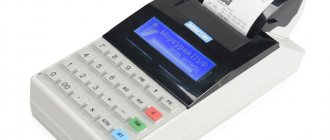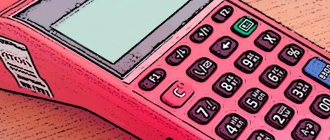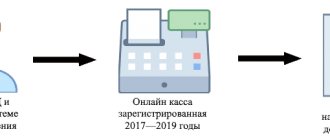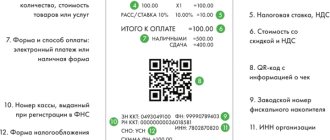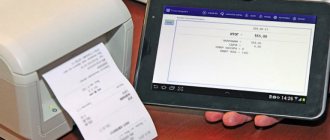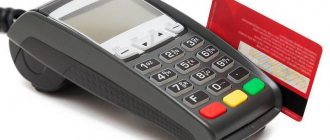The essence of the process of implementing online cash registers
From 07/01/2017, cash registers of a new type - online cash registers, characterized by:
- a higher degree of security for sales data generated on them;
- the ability to transmit this data in real time to the Federal Tax Service.
At the same time, a number of changes were introduced:
- to the list of persons obliged to use CCP;
- procedure for registering and using cash registers;
- register of mandatory details of documents generated by the cash desk.
To learn how the change in the list of persons required to use cash registers affected the stages of implementation of online devices, read the article “Who should switch to online cash registers from July 1, 2019?”
However, despite a fairly wide range of changes in working with cash register systems, the essence of these changes boils down to the fact that cash registers of a technically higher level began to be used for cash payments. And it was precisely this circumstance that caused most of the changes in the procedure for working with them. These changes did not affect the rules for accounting for revenue received through cash register systems, despite a number of innovations in the documentation of some cash transactions. Therefore, the question of how to keep records at online cash registers has only one answer: in the same order as before. There are no innovations in it.
Some businesses, usually online stores, prefer to use cloud services instead of cash registers. A cloud online cash register is a service through which an online store connects to a remote online machine located in the service’s data center. All information about calculations is carried out through this device, which is transmitted through the fiscal data operator to the tax office. And the cloud service ensures the connection of cash registers to the online store website, setting up online cash registers and uninterrupted access to them.
The cloud service allows you to rent several cash registers without a cash register and register them with the tax office.
conclusions
The write-off of cash registers is carried out by an economic entity according to the general rules usually applied for fixed assets.
It should be taken into account, however, that such a write-off must be preceded by the proper removal of the cash register device from official registration with the territorial department of the Federal Tax Service.
The write-off procedure is carried out in a certain order. The relevant documents must be filled out.
Of particular importance may be an administrative act of the management of a legal entity, authorizing the decommissioning of the apparatus on the basis of the conclusion of a special commission, also formed by a separate order of the management.
Changes in the processing of documents at the cash desk
A new approach to documents drawn up when using cash registers was outlined with the appearance of the updated text of Art. 1, paragraph 1 of which now states that when using cash register equipment one should be guided by:
- Law No. 54-FZ itself;
- regulations adopted in accordance with it.
That is, this automatically abolished the need to prepare previously considered mandatory documents, the unified forms of which were approved by Decree of the State Statistics Committee of December 25, 1998 No. 132:
- Acts:
- on transferring cash meter readings to zero (form KM-1);
- on taking meter readings when transferring the cash register for repairs (form KM-2);
- on the return of money to customers (form KM-3);
- on checking cash at the cash desk (form KM-9).
- Magazines:
- cashier-operator (form KM-4), letter of the Ministry of Finance of Russia dated June 16, 2017 No. 03-01-15/37692;
- registration of meter readings (form KM-5);
- recording calls from technical specialists (form KM-8).
- Reference reports:
- certificate-report of the cashier-operator (form KM-6);
- information on meter readings and revenue (form KM-7).
- shift opening report;
- correction cash receipt;
- report on closing the fiscal drive;
- operator confirmation.
- refund to the buyer;
- issuing funds to the client;
- receiving funds from the client.
At the same time, new documents that are related to cash payments made using online cash registers have been approved by Law No. 54-FZ (clause 4 of article 4.1):
Other documents have changed their form and requirements for details. With the use of the main cash document (check or BSO), it became possible not only to process receipts for purchases, but also such operations as (Clause 1, Article 4.7 of Law No. 54-FZ):
However, changes in documents drawn up using cash registers did not in any way affect the rules for maintaining documentation for the operating cash desk, approved by the Bank of Russia Directive No. 3210-U dated March 11, 2014. Therefore, it is still required to issue cash orders for receipts and expenses (clause 4.1) and maintain a cash book (clause 4.6). In relation to cash revenue, it will be mandatory to register it daily according to a receipt order, drawn up on the basis of a shift closing report generated on the online cash register, which is an analogue of the z-report created at the cash register with ECLZ.
You can find out more about the documents that are required to be completed using CCP in various situations in ConsultantPlus. Trial access to the legal system is free.
Let's look at how to organize cash accounting in the cash register.
Recycling cash registers
Cash registers that are no longer needed by entrepreneurs due to obsolescence, exhaustion, or changes in the requirements for this equipment cannot simply be taken to the trash can or taken to a landfill. After all, such equipment undergoes a numbered registration with the tax authorities, in addition, it contains environmentally hazardous substances. Therefore, disposal must take place in a manner specifically regulated by law, violation of which is fraught with punishment. Let's look at how to write off and dispose of cash register equipment correctly.
Accounting for cash receipts
Revenue accepted into the online cash register is reflected in the taxpayer’s operating cash register. This procedure is recorded by postings:
- in retail trade that does not provide for customer analytics:
Dt 50 Kt 90.1;
- for cash payments with customers who are legal entities or individual entrepreneurs, in respect of which analytical accounting is important:
Dt 50 Kt 62 and Dt 62 Kt 90.1.
If payments are made using a plastic card, then account 57 is involved in the transactions:
Dt 57 Kt 90.1 or Dt 57 Kt 62.
Read more about using account 57 in the material “Posting debit 57 credit 57 (nuances)” .
Whether it is necessary to use cash register systems for non-cash payments, read in ConsultantPlus. Get trial access to the system and go to the Ready-made solution.
Cash register breakdowns
Like any equipment, cash registers tend to break down.
You can fix some breakdowns yourself if you know the basics of how a cash register works. We have already examined the design when disassembling the Shtrikh non-autonomous cash register (follow the link - an article about disassembly on our website). There's nothing complicated there. Now let's look at what most often happens to cash registers and why they fail. Let's make a list of the TOP breakdowns.
But before you start discussing breakdowns and their elimination, you need to remember - a cash register is an official thing and its disassembly and repair can bring you a number of problems. You can't just take the cash register apart. You need to obtain special permission from the Federal Tax Service in order to break the seals on the device and unscrew the bolts. It follows from this that it is undesirable to carry out independent repairs in difficult cases, just as it is undesirable to entrust the work to a private master.
Accounting for refunds to the buyer for goods
Reflection in accounting for a refund for goods returned by the buyer depends on when this event occurred:
- in the same tax period with the sale (and it does not matter whether the day of sale coincides with the day of return) - in this case, reversing entries are used;
- different tax periods - here the return during the period of its implementation will have to be reflected through non-operating income and expenses.
Separately from the receipt of revenue, the return transaction will be shown even if the day of return coincides with the day of sale, since Law No. 54-FZ (clauses 1 and 4 of article 4.1, clause 3 of article 4.3, clause 1 of article 4.7) requires separate registration, storage and transfer to the Federal Tax Service of each document generated by the cash desk.
Accounting transactions using reversing entries will look like this:
- goods received from buyer:
Dt 41 Kt 76 (62);
- refund made:
Dt 76 (62) Kt 50 (51);
- adjusted revenue:
Dt 76 (62) Kt 90.1 reversal;
- Corrections have been made to write off the cost of goods sold:
Dt 90.2 Kt 76 (62) reversal.
If retail accounting is kept at sales prices, then upon return there will be an entry to restore the amount of the trade margin:
Dt 90.2 Kt 42.
If the tax periods of the sale and return do not coincide, then in the last 3 transactions, instead of subaccounts 90, account 91 with similar subaccount numbers will be used.
With regard to adjusting the amount of VAT on sales (if the seller works with this tax), it should be taken into account that here, in accordance with the requirements of the Tax Code of the Russian Federation (clause 5 of Article 171), it will be necessary to make a deduction for the amount of tax corresponding to the amount of the refund. In this case, the purchase book must contain the details of either an adjustment invoice or an expense cash order that formalized the issuance of money to the buyer (letter of the Ministry of Finance of Russia dated March 19, 2013 No. 03-07-15/8473).
Since for the correct implementation of the deduction (indicating the details of the document giving the right to it), the VAT amount must be reflected on account 19, the logical entry for reflecting the amount intended for deduction would be:
Dt 90.3 Kt 19 reversal.
It will essentially replace 2 entries: for adjusting VAT on revenue (Dt 90.3 Kt 68 reversal) and for calculating the same amount of tax for deduction (Dt 19 Kt 68 or Dt 68 Kt 19 reversal).
The deduction for the amount reflected in account 19 on the date of its accrual will be made by the usual posting for it:
Dt 68 Kt 19.
Read more about creating a purchase book in the article “What are the basic rules for filling out and maintaining a purchase book?” .
What is needed to open a current account
First you will need to open an individual entrepreneur, visit the Social Insurance Fund, the Pension Fund and the tax service. Then an account is created.
The bank will need to provide a package of documents, which is usually standard for all institutions:
- Photocopy of the entrepreneur's passport (pages with photos and a spread with a registration stamp).
- Certificate of registration of individual entrepreneur. If the data has already been entered into the Unified State Register of Individual Entrepreneurs, an extract is provided.
- Certificate from the tax office.
- If 3 months have passed since the registration of the business, then a copy of the annual or quarterly tax reporting is presented.
- A copy of the annual accounting report.
- Licenses, if any, are issued and necessary to conduct activities.
- Definition of activities according to OKVED.
Rate how useful the information in the article was? ( 2 ratings, average: 5.00 out of 5)
Accounting for other settlements with the client
Other cash payments with the client at the cash desk may include:
- payments for goods accepted for commission;
- payment for recyclable materials purchased from the population;
- issuance of winnings;
- settlements under an agency agreement.
These are expense transactions documented by posting:
Dt 76 (60) Kt 50 (51).
The account number options on the debit portion of this entry will depend on what is written in the accounting policies regarding the accounting for a particular payment. And in the credit part for the situation of transferring money to a plastic card, an account of 51 will appear.
Accordingly, when returning funds issued to the client, a reverse posting will occur, in which account 57 will participate when making payments through a plastic card:
Dt 50 (57) Kt 76 (60).
Read about the nuances of recording transactions under an agency agreement in the material “Features of an agency agreement in accounting .
Check won't be cut
As you know, in any technology, the mechanical part most often breaks down in an electronic device. There are quite a lot of mechanics at the box office (by modern standards). One of the mechanical components is a check cutter. It may become dull, break, bend, or cut inaccurately. If inaccuracies are observed in the work, this can be adjusted. If the problem is extremely bad, then the knife needs to be replaced. The problem is not dangerous, but again, you will need to disassemble the cash register.
Results
The transition to the use of online cash registers essentially represents the replacement of previously used cash register systems with higher-level technology, which makes it possible to better protect cash register data from changes and increase the degree of control of the tax authorities over them. It is with this kind of changes that the main aspects of updating the procedure for using CCP are associated. Despite the fact that their consequence was the abolition of the obligation to use some documents previously drawn up when using cash registers, these changes did not affect the procedure for reflecting in accounting transactions related to the acceptance and issuance of cash through cash registers. Therefore, accounting for the movement of funds passing through the cash register is carried out in the same manner.
You can find more complete information on the topic in ConsultantPlus. Free trial access to the system for 2 days.
How to write off cash register equipment - a step-by-step process for writing off cash registers and a sample order
The cash register (CRE), used by a business entity for cash payments to the population, can fail at any time.
The CCT device has a useful life, which is set by the manufacturer and, accordingly, ends after a specific period of time.
All these points are considered typical not only for a cash register, but also for any other technical device that is an object of fixed assets.
The most correct measure in such situations is to write off the cash register device in compliance with all the necessary formalities.
Under what circumstances is a cash register device decommissioned, what is the procedure for carrying out this procedure - all these issues need to be considered in more detail.
The cashier cannot open/close a shift
This is more of a software failure. You need to start working with the software. Often this error appears due to an incorrect action in the previous cash register shift.
If, when opening a shift, an error appears that the cash register shift in the system is not closed, this means that the cash register shift for the previous day was not closed. To fix this error, you need to close the RMK mode by clicking the close button.
If, when trying to open a shift, an error appears that the shift in the system has not yet been closed, the shift has been open for more than 24 hours, or the shift cannot be opened with the CCP status, then you need to close the RMK mode.
If you cannot close the shift, try rebooting the device and repeating the procedure again. You probably did not manage to meet the 24 interval.
Broken receipt printing tape
The problem with the cash register tape is one of the most common. In almost all cash registers, it will not be possible to carry out a transaction if the cash register tape is jammed. Sensors are located inside the device that monitor the operation of the tape feed mechanism.
To solve the problem, you need to restore the operation of the cash register mechanism. If the tape is jammed, you need to take out the spool of tape, straighten the tape, tear off the damaged area and start the process again. If the tape runs out, the tape should be replaced. If the tape breaks due to a jam, etc., then print the receipt again.
